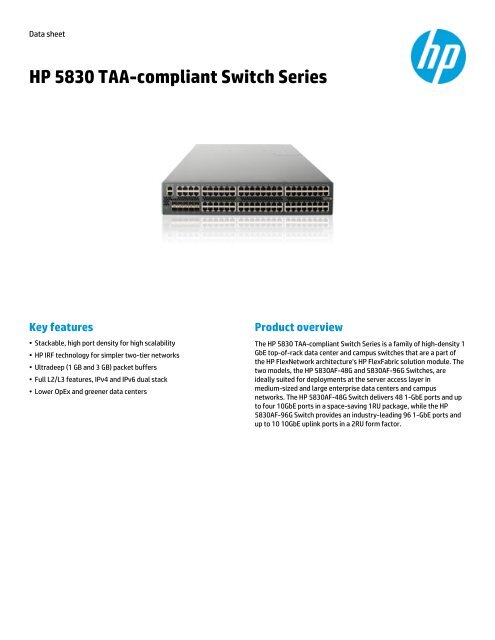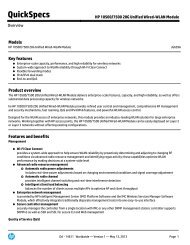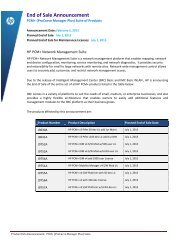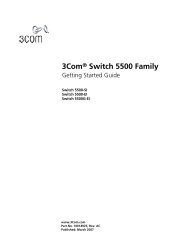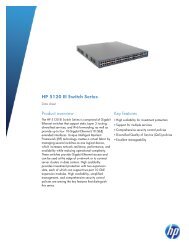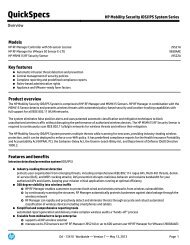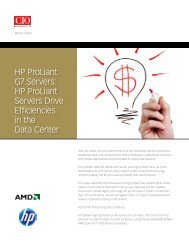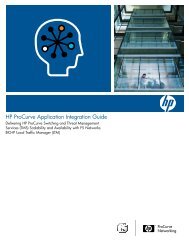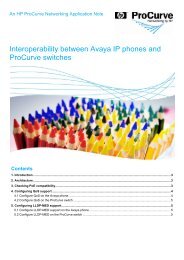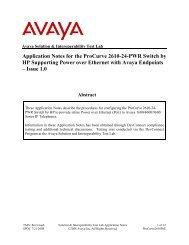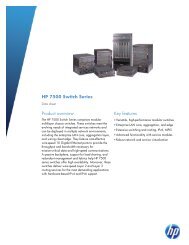Datasheet - HP Networking
Datasheet - HP Networking
Datasheet - HP Networking
You also want an ePaper? Increase the reach of your titles
YUMPU automatically turns print PDFs into web optimized ePapers that Google loves.
Data sheet<br />
<strong>HP</strong> 5830 TAA-compliant Switch Series<br />
Key features<br />
• Stackable, high port density for high scalability<br />
• <strong>HP</strong> IRF technology for simpler two-tier networks<br />
• Ultradeep (1 GB and 3 GB) packet buffers<br />
• Full L2/L3 features, IPv4 and IPv6 dual stack<br />
• Lower OpEx and greener data centers<br />
Product overview<br />
The <strong>HP</strong> 5830 TAA-compliant Switch Series is a family of high-density 1<br />
GbE top-of-rack data center and campus switches that are a part of<br />
the <strong>HP</strong> FlexNetwork architecture's <strong>HP</strong> FlexFabric solution module. The<br />
two models, the <strong>HP</strong> 5830AF-48G and 5830AF-96G Switches, are<br />
ideally suited for deployments at the server access layer in<br />
medium-sized and large enterprise data centers and campus<br />
networks. The <strong>HP</strong> 5830AF-48G Switch delivers 48 1-GbE ports and up<br />
to four 10GbE ports in a space-saving 1RU package, while the <strong>HP</strong><br />
5830AF-96G Switch provides an industry-leading 96 1-GbE ports and<br />
up to 10 10GbE uplink ports in a 2RU form factor.
Features and benefits<br />
Quality of Service (QoS)<br />
• Traffic policing<br />
supports Committed Access Rate (CAR) and line rate<br />
• Powerful QoS feature<br />
creates traffic classes based on access control lists (ACLs), IEEE<br />
802.1p precedence, IP, DSCP, or Type of Service (ToS) precedence;<br />
supports filter, redirect, mirror, or remark; supports the following<br />
congestion actions: strict priority (SP) queuing, weighted round<br />
robin (WRR), weighted fair queuing (WFQ), weighted random early<br />
discard (WRED), SP+WRR, and SP+WFQ<br />
Management<br />
• sFlow (RFC 3176)<br />
provides scalable ASIC-based wire-speed network monitoring and<br />
accounting with no impact on network performance; this allows<br />
network operators to gather a variety of sophisticated network<br />
statistics and information for capacity planning and real-time<br />
network monitoring purposes<br />
• Remote configuration and management<br />
is available through a secure Web browser or a CLI<br />
• Manager and operator privilege levels<br />
enable read-only (operator) and read/write (manager) access on CLI<br />
and Web browser management interfaces<br />
• Management VLAN<br />
segments traffic to and from management interfaces, including<br />
CLI/telnet, a Web browser interface, and SNMP<br />
• Multiple configuration files<br />
can be stored to the flash image<br />
• Secure Web GUI<br />
provides a secure, easy-to-use graphical interface for configuring<br />
the module via HTTPS<br />
• SNMPv1, v2c, and v3<br />
facilitate centralized discovery, monitoring, and secure<br />
management of networking devices<br />
• Remote monitoring (RMON)<br />
uses standard SNMP to monitor essential network functions;<br />
supports events, alarm, history, and statistics group plus a private<br />
alarm extension group<br />
• Network Time Protocol (NTP)<br />
synchronizes timekeeping among distributed time servers and<br />
clients; keeps timekeeping consistent among all clock-dependent<br />
devices within the network so that the devices can provide diverse<br />
applications based on the consistent time<br />
• Out-of-band interface<br />
isolates management traffic from user data plane traffic for<br />
complete isolation and total reachability, no matter what happens<br />
in the data plane<br />
• Remote intelligent mirroring<br />
mirrors ingress/egress ACL-selected traffic from a switch port or<br />
VLAN to a local or remote switch port anywhere on the network<br />
Connectivity<br />
• Jumbo frames<br />
on Gigabit Ethernet and 10-Gigabit Ethernet ports, jumbo frames<br />
allow high-performance remote backup and disaster-recovery<br />
services<br />
• Auto-MDIX<br />
automatically adjusts for straight-through or crossover cables on<br />
all 10/100/1000 ports<br />
• IPv6 native support<br />
– IPv6 host<br />
enables switches to be managed and deployed at the IPv6<br />
network's edge<br />
– Dual stack (IPv4 & IPv6)<br />
transitions from IPv4 to IPv6, supporting connectivity for both<br />
protocols<br />
– Multicast Listener Discovery (MLD) snooping<br />
IPv6 multicast traffic to the appropriate interface<br />
– IPv6 ACL/QoS<br />
supports ACL and QoS for IPv6 network traffic, preventing traffic<br />
flooding<br />
– IPv6 routing<br />
supports IPv6 static routes, RIP, BGP4+v6, IS-ISv6, and OSPF<br />
routing protocols<br />
Performance<br />
• Extraordinarily high port density<br />
the <strong>HP</strong> 5830AF-96G Switch is a single box-type switch that can<br />
provide 96 GbE ports and 10 10GbE ports simultaneously with full<br />
line-rate switching and forwarding<br />
• Ultradeep packet buffering<br />
provides up to a 3 GB packet buffer to help eliminate network<br />
congestion at the I/O associated with heavy use of server<br />
virtualization, as well as bursty multimedia, storage applications,<br />
and other critical services<br />
• Hardware-based wire-speed access control lists (ACLs)<br />
feature-rich ACL implementation (TCAM based) helps provide high<br />
levels of security and ease of administration without impacting<br />
network performance<br />
• Local Address Resolution Protocol (ARP)<br />
ARP fast reply feature provides an outstanding utilization of<br />
air-interface resources by first issuing an ARP request locally before<br />
the AP broadcasts over the radio interface<br />
Resiliency and high availability<br />
• Device Link Detection Protocol (DLDP)<br />
monitors link connectivity and shuts down ports at both ends if<br />
unidirectional traffic is detected, preventing loops in STP-based<br />
networks<br />
2
• Virtual Router Redundancy Protocol (VRRP)<br />
allows groups of two routers to dynamically back each other up to<br />
create highly available routed environments<br />
• Intelligent Resilient Framework (IRF)<br />
creates virtual resilient switching fabrics, where two or more<br />
switches perform as a single L2 switch and L3 router; switches do<br />
not have to be co-located and can be part of a disaster-recovery<br />
system; servers or switches can be attached using standard LACP<br />
for automatic load balancing and high availability; can eliminate the<br />
need for complex protocols like Spanning Tree Protocol, Equal-Cost<br />
Multipath (ECMP), or VRRP, thereby simplifying network operation<br />
• Rapid Ring Protection Protocol (RRPP)<br />
connects multiple switches in a high-performance ring using<br />
standard Ethernet technology; traffic can be rerouted around the<br />
ring in less than 200 ms, reducing the impact on traffic and<br />
applications<br />
• Smart link<br />
allows 200 ms failover between links<br />
• Data center optimized design<br />
supports front-to-back/back-to-front airflow for hot/cold aisles,<br />
rear rack mounts, and redundant hot-swappable AC or DC power<br />
and fans<br />
Manageability<br />
• Troubleshooting<br />
ingress and egress port monitoring enable network problem solving<br />
Layer 2 switching<br />
• Spanning Tree/MSTP and RSTP<br />
prevent network loops<br />
• Internet Group Management Protocol (IGMP) and Multicast<br />
Listener Discovery (MLD) protocol snooping<br />
effectively control and manage the flooding of multicast packets in<br />
a Layer 2 network<br />
• 32K MAC addresses<br />
provide access to many Layer 2 devices<br />
• IEEE 802.1ad QinQ and Selective QinQ<br />
increase the scalability of an Ethernet network by providing a<br />
hierarchical structure; connect multiple LANs on a high-speed<br />
campus or metro network<br />
• 10GbE port aggregation<br />
allows grouping of ports to increase overall data throughput to a<br />
remote device<br />
• Port isolation<br />
increases security by isolating ports within a VLAN while still<br />
allowing them to communicate with other VLANs<br />
• Per-VLAN Spanning Tree Plus (PVST+)<br />
allows each VLAN to build a separate spanning tree to improve link<br />
bandwidth usage in network environments where multiple VLANs<br />
exist<br />
• GVRP VLAN Registration Protocol<br />
allows automatic learning and dynamic assignment of VLANs<br />
Layer 3 services<br />
• Loopback interface address<br />
defines an address in Routing Information Protocol (RIP) and Open<br />
Standard Path First (OSPF), improving diagnostic capability<br />
• User Datagram Protocol (UDP) helper function<br />
allows UDP broadcasts to be directed across router interfaces to<br />
specific IP unicast or subnet broadcast addresses and prevents<br />
server spoofing for UDP services such as DHCP<br />
• Route maps<br />
provide more control during route redistribution; allow filtering and<br />
altering of route metrics<br />
• Dynamic Host Configuration Protocol (DHCP)<br />
simplifies the management of large IP networks and supports client<br />
and server; DHCP Relay enables DHCP operation across subnets<br />
Layer 3 routing<br />
• Bidirectional Forwarding Detection (BFD)<br />
enables link connectivity monitoring and reduces network<br />
convergence time for RIP, OSPF, BGP, IS-IS, VRRP, and IRF<br />
• IPv6 tunneling<br />
is an important element for the transition from IPv4 to IPv6; allows<br />
IPv6 packets to traverse IPv4-only networks by encapsulating the<br />
IPv6 packet into a standard IPv4 packet; supports manually<br />
configured, 6to4, and Intra-Site Automatic Tunnel Addressing<br />
Protocol (ISATAP) tunnels<br />
• Policy-based routing<br />
makes routing decisions based on policies set by the network<br />
administrator<br />
• IGMPv1, v2, and v3<br />
allow individual hosts to be registered on a particular VLAN<br />
• PIM-SSM, PIM-DM, and PIM-SM (for IPv4 and IPv6)<br />
support IP Multicast address management and inhibition of DoS<br />
attacks<br />
• Layer 3 IPv4 routing<br />
provides routing of IPv4 at media speed; supports static routes, RIP<br />
and RIPv2, OSPF, IS-IS, and BGP<br />
• Equal-Cost Multipath (ECMP)<br />
enables multiple equal-cost links in a routing environment to<br />
increase link redundancy and scale bandwidth<br />
• Layer 3 IPv6 routing<br />
provides routing of IPv6 at media speed; supports static routes,<br />
RIPng, OSPFv3, IS-ISv6, and MP-BGP<br />
Security<br />
• Access control lists (ACLs)<br />
provide IP Layer 3 filtering based on source/destination IP<br />
address/subnet and source/destination TCP/UDP port number<br />
3
• Secure shell<br />
encrypts all transmitted data for secure remote CLI access over IP<br />
networks<br />
• Port security<br />
allows access only to specified MAC addresses, which can be learned<br />
or specified by the administrator<br />
• Secure FTP<br />
allows secure file transfer to and from the switch; protects against<br />
unwanted file downloads or unauthorized copying of a switch<br />
configuration file<br />
• Secure management access<br />
securely encrypts all access methods (CLI, GUI, or MIB) through<br />
SSHv2, SSL, and/or SNMPv3<br />
• Identity-driven security and access control<br />
– Per-user ACLs<br />
permits or denies user access to specific network resources based<br />
on user identity, location, and time of day, allowing multiple types<br />
of users on the same network to access specific network services<br />
without risk to network security or unauthorized access to<br />
sensitive data<br />
– Automatic VLAN assignment<br />
automatically assigns users to the appropriate VLAN based on<br />
their identity and location, and the time of day<br />
• STP BPDU port protection<br />
blocks Bridge Protocol Data Units (BPDUs) on ports that do not<br />
require BPDUs, preventing forged BPDU attacks<br />
• DHCP protection<br />
blocks DHCP packets from unauthorized DHCP servers, preventing<br />
denial-of-service attacks<br />
• Dynamic ARP protection<br />
blocks ARP broadcasts from unauthorized hosts, preventing<br />
eavesdropping or theft of network data<br />
• STP Root Guard<br />
protects the root bridge from malicious attacks or configuration<br />
mistakes<br />
• Guest VLAN<br />
similar to IEEE 802.1X, it provides a browser-based environment to<br />
authenticated clients<br />
• MAC-based authentication<br />
allows or denies access to the switch based on a client MAC address<br />
• IP Source Guard<br />
helps prevent IP spoofing attacks<br />
• Endpoint Admission Defense (EAD)<br />
provides security policies to users accessing a network<br />
• RADIUS/HWTACACS<br />
eases switch management security administration by using a<br />
password authentication server<br />
Convergence<br />
• IP multicast snooping (data-driven IGMP)<br />
automatically prevents flooding of IP multicast traffic<br />
• IEEE 802.1AB Link Layer Discovery Protocol (LLDP)<br />
is an automated device discovery protocol that provides easy<br />
mapping of network management applications<br />
• Internet Group Management Protocol (IGMP)<br />
is used by IP hosts to establish and maintain multicast groups;<br />
supports IGMPv1, v2, and v3; utilizes Any-Source Multicast (ASM) or<br />
Source-Specific Multicast (SSM) to manage IPv4 multicast networks<br />
• Protocol Independent Multicast (PIM)<br />
is used for IPv4 and IPv6 multicast applications; supports PIM Dense<br />
Mode (PIM-DM), Sparse Mode (PIM-SM), and Source-Specific Mode<br />
(PIM-SSM)<br />
• Multicast Source Discovery Protocol (MSDP)<br />
is used for inter-domain multicast applications, allowing multiple<br />
PIM-SM domains to interoperate<br />
• Multicast Border Gateway Protocol (MBGP)<br />
allows multicast traffic to be forwarded across BGP networks and<br />
kept separate from unicast traffic<br />
• Multicast VLAN<br />
allows multiple VLANs to receive the same IPv4 or IPv6 multicast<br />
traffic, lessening network bandwidth demand by reducing or<br />
eliminating multiple streams to each VLAN<br />
• LLDP-MED<br />
is a standard extension that automatically configures network<br />
devices, including LLDP-capable IP phones<br />
• LLDP-CDP compatibility<br />
receives and recognizes CDP packets from Cisco's IP phones for<br />
seamless interoperation<br />
Monitor and diagnostics<br />
• Port mirroring<br />
enables traffic on a port to be simultaneously sent to a network<br />
analyzer for monitoring<br />
• OAM ( IEEE 802.3ah)<br />
operations, administration and maintenance (OAM) management<br />
capability detects data link layer problems that occurred in the "last<br />
mile"; monitors the status of the link between the two devices<br />
• CFD (IEEE 802.1ag)<br />
connectivity fault detection (CFD) provides a Layer 2 link OAM<br />
mechanism used for link connectivity detection and fault locating<br />
Additional information<br />
• Green initiative support<br />
provides support for RoHS and WEEE regulations<br />
• Green IT and power<br />
use the latest advances in silicon development, shut off unused<br />
ports, and use variable-speed fans to improve energy efficiency<br />
4
Warranty and support<br />
• 1-year warranty<br />
with advance replacement and next-business-day delivery<br />
(available in most countries)<br />
• Electronic and telephone support<br />
limited electronic and telephone support is available from <strong>HP</strong>; to<br />
reach our support centers, refer to<br />
www.hp.com/networking/contact-support; for details on the<br />
duration of support provided with your product purchase, refer to<br />
www.hp.com/networking/warrantysummary<br />
• Software releases<br />
to find software for your product, refer to<br />
www.hp.com/networking/support; for details on the software<br />
releases available with your product purchase, refer to<br />
www.hp.com/networking/warrantysummary<br />
5
<strong>HP</strong> 5830 TAA-compliant Switch Series<br />
Specifications<br />
<strong>HP</strong> 5830AF-48G TAA-compliant Switch w/1 Interface Slot (JG316A)<br />
<strong>HP</strong> 5830AF-96G TAA-compliant Switch (JG374A)<br />
Ports 48 RJ-45 autosensing 10/100/1000 ports (IEEE 802.3 Type 10BASE-T, IEEE 802.3u<br />
Type 100BASE-TX, IEEE 802.3ab Type 1000BASE-T); Duplex: 10BASE-T/100BASE-TX:<br />
half or full; 1000BASE-T: full only<br />
2 dual-personality ports; auto-sensing 10/100/1000Base-T or SFP<br />
2 fixed 1000/10000 SFP+ ports<br />
1 RJ-45 serial console port<br />
96 RJ-45 autosensing 10/100/1000 ports (IEEE 802.3 Type 10BASE-T, IEEE 802.3u<br />
Type 100BASE-TX, IEEE 802.3ab Type 1000BASE-T); Duplex: 10BASE-T/100BASE-TX:<br />
half or full; 1000BASE-T: full only<br />
10 fixed 1000/10000 SFP+ ports<br />
1 RJ-45 serial console port<br />
1 RJ-45 out-of-band management port<br />
1 RJ-45 out-of-band management port<br />
Power supplies<br />
Fan tray<br />
1 extended module slot<br />
2 power supply slots<br />
1 minimum power supply required (ordered separately)<br />
1 fan tray slot<br />
Base product does not include fan tray.<br />
2 power supply slots<br />
1 minimum power supply required (ordered separately)<br />
1 fan tray slot<br />
Base product does not include fan tray.<br />
Physical characteristics<br />
17.32(w) x 18.11(d) x 1.72(h) in (43.99 x 46 x 4.37 cm) (1U height)<br />
17.32(w) x 25.98(d) x 3.39(h) in (43.99 x 65.99 x 8.61 cm)<br />
Weight 14.53 lb (6.59 kg) 31.75 lb (14.4 kg)<br />
Memory and processor<br />
64 MB flash, 1 GB SDRAM; packet buffer size: 1 GB 64 MB flash, 1 GB SDRAM; packet buffer size: 3 GB<br />
Performance<br />
Throughput 119 million pps (64-byte packets) 291.6 million pps (64-byte packets)<br />
Switching capacity 160 Gbps 392 Gbps<br />
Routing table size 12000 entries 12000 entries<br />
MAC address table size 32000 entries 32000 entries<br />
Environment<br />
Operating temperature 32°F to 113°F (0°C to 45°C) 32°F to 113°F (0°C to 45°C)<br />
Operating relative humidity 5% to 95% 5% to 95%<br />
Acoustic Low-speed fan: 58 dB, High-speed fan: 65 dB Low-speed fan: 58 dB, High-speed fan: 65 dB<br />
Electrical characteristics<br />
Maximum heat dissipation 440 BTU/hr (464.2 kJ/hr) 1209 BTU/hr (1275.49 kJ/hr)<br />
Voltage 100-240 VAC 100-240 VAC<br />
DC voltage -40 to -60 VDC -40 to -60 VDC<br />
Frequency 50/60 Hz 50/60 Hz<br />
Safety<br />
Emissions<br />
UL 60950-1; EN 60825-1 Safety of Laser Products-Part 1; EN 60825-2 Safety of Laser<br />
Products-Part 2; IEC 60950-1; CAN/CSA-C22.2 No. 60950-1; Anatel; ULAR; GOST; EN<br />
60950-1/A11; FDA 21 CFR Subchapter J; NOM; ROHS Compliance<br />
VCCI Class A; EN 55022 Class A; ICES-003 Class A; ETSI EN 300 386 V1.3.3; AS/NZS<br />
CISPR22 Class A; EMC Directive 2004/108/EC; EN 55024:1998+ A1:2001 + A2:2003; FCC<br />
(CFR 47, Part 15) Subpart B Class A<br />
UL 60950-1; EN 60825-1 Safety of Laser Products-Part 1; EN 60825-2 Safety of Laser<br />
Products-Part 2; IEC 60950-1; CAN/CSA-C22.2 No. 60950-1; Anatel; ULAR; GOST; EN<br />
60950-1/A11; FDA 21 CFR Subchapter J; NOM; ROHS Compliance<br />
VCCI Class A; EN 55022 Class A; ICES-003 Class A; ETSI EN 300 386 V1.3.3; AS/NZS<br />
CISPR22 Class A; EMC Directive 2004/108/EC; EN 55024:1998+ A1:2001 + A2:2003; FCC<br />
(CFR 47, Part 15) Subpart B Class A<br />
Immunity<br />
Generic ETSI EN 300 386 V1.3.3 ETSI EN 300 386 V1.3.3<br />
EN EN 55024:1998+ A1:2001 + A2:2003 EN 55024:1998+ A1:2001 + A2:2003<br />
ESD EN 61000-4-2; IEC 61000-4-2 EN 61000-4-2; IEC 61000-4-2<br />
Radiated EN 61000-4-3; IEC 61000-4-3 EN 61000-4-3; IEC 61000-4-3<br />
EFT/Burst EN 61000-4-4; IEC 61000-4-4 EN 61000-4-4; IEC 61000-4-4<br />
Surge EN 61000-4-5; IEC 61000-4-5 EN 61000-4-5; IEC 61000-4-5<br />
Conducted EN 61000-4-6; IEC 61000-4-6 EN 61000-4-6; IEC 61000-4-6<br />
Power frequency magnetic field EN 61000-4-8; IEC 61000-4-8 EN 61000-4-8; IEC 61000-4-8<br />
Voltage dips and interruptions EN 61000-4-11; IEC 61000-4-11 EN 61000-4-11; IEC 61000-4-11<br />
Harmonics EN 61000-3-2, IEC 61000-3-2 EN 61000-3-2, IEC 61000-3-2<br />
Flicker EN 61000-3-3, IEC 61000-3-3 EN 61000-3-3, IEC 61000-3-3<br />
Management<br />
IMC - Intelligent Management Center; command-line interface; Web browser;<br />
out-of-band management; SNMP Manager; Telnet; RMON1; FTP; IEEE 802.3 Ethernet<br />
MIB<br />
IMC - Intelligent Management Center; command-line interface; Web browser;<br />
out-of-band management; SNMP Manager; Telnet; RMON1; FTP; IEEE 802.3 Ethernet<br />
MIB<br />
6
<strong>HP</strong> 5830 TAA-compliant Switch Series<br />
Specifications (continued)<br />
Notes<br />
Services<br />
<strong>HP</strong> 5830AF-48G TAA-compliant Switch w/1 Interface Slot (JG316A)<br />
Additional specifications:<br />
• Static MAC table: 5120<br />
• Max VLAN interface: 1,000<br />
• Multicast L2 entries for IPv4: 2,000<br />
• Multicast L2 entries for IPv6: 1,000<br />
• Multicast L3 entries for IPv4: 2,000<br />
• Multicast L3 entries for IPv6: 1,000<br />
• VLAN table: 4,000<br />
• QoS forward queue number: 8<br />
• Static ARP number: 1,000<br />
• Dynamic ARP number: 8,000<br />
• Max number in one link group: 8<br />
• Link group number: 128<br />
• ACL number: 4,000 (ingress); 512 (egress)<br />
Refer to the <strong>HP</strong> website at www.hp.com/networking/services for details on the<br />
service-level descriptions and product numbers. For details about services and<br />
response times in your area, please contact your local <strong>HP</strong> sales office.<br />
<strong>HP</strong> 5830AF-96G TAA-compliant Switch (JG374A)<br />
Additional specifications:<br />
• Static MAC table: 5120<br />
• Max VLAN interface: 1,000<br />
• Multicast L2 entries for IPv4: 2,000<br />
• Multicast L2 entries for IPv6: 1,000<br />
• Multicast L3 entries for IPv4: 2,000<br />
• Multicast L3 entries for IPv6: 1,000<br />
• VLAN table: 4,000<br />
• QoS forward queue number: 8<br />
• Static ARP number: 1,000<br />
• Dynamic ARP number: 8,000<br />
• Max number in one link group: 8<br />
• Link group number: 128<br />
• ACL number (GbE ports): 8,000 (ingress); 1,000 (egress)<br />
• ACL number (10GbE ports): 2,000 (ingress); 512 (egress)<br />
Refer to the <strong>HP</strong> website at www.hp.com/networking/services for details on the<br />
service-level descriptions and product numbers. For details about services and<br />
response times in your area, please contact your local <strong>HP</strong> sales office.<br />
7
<strong>HP</strong> 5830 TAA-compliant Switch Series<br />
Specifications (continued)<br />
<strong>HP</strong> 5830AF-48G TAA-compliant Switch w/1 Interface Slot (JG316A)<br />
<strong>HP</strong> 5830AF-96G TAA-compliant Switch (JG374A)<br />
Standards and protocols<br />
(applies to all products in series)<br />
BGP<br />
RFC 1771 BGPv4<br />
RFC 1772 Application of the BGP<br />
RFC 1965 BGP4 confederations<br />
RFC 1997 BGP Communities Attribute<br />
RFC 1998 PPP Gandalf FZA Compression Protocol<br />
RFC 2385 BGP Session Protection via TCP MD5<br />
RFC 2439 BGP Route Flap Damping<br />
RFC 2796 BGP Route Reflection<br />
RFC 2858 BGP-4 Multi-Protocol Extensions<br />
RFC 2918 Route Refresh Capability<br />
RFC 3065 Autonomous System Confederations for BGP<br />
RFC 3392 Capabilities Advertisement with BGP-4<br />
RFC 4271 A Border Gateway Protocol 4 (BGP-4)<br />
RFC 4272 BGP Security Vulnerabilities Analysis<br />
RFC 4273 Definitions of Managed Objects for BGP-4<br />
RFC 4274 BGP-4 Protocol Analysis<br />
RFC 4275 BGP-4 MIB Implementation Survey<br />
RFC 4276 BGP-4 Implementation Report<br />
RFC 4277 Experience with the BGP-4 Protocol<br />
RFC 4360 BGP Extended Communities Attribute<br />
RFC 4456 BGP Route Reflection: An Alternative to Full<br />
Mesh Internal BGP (IBGP)<br />
RFC 5291 Outbound Route Filtering Capability for BGP-4<br />
RFC 5292 Address-Prefix-Based Outbound Route Filter<br />
for BGP-4<br />
Denial of service protection<br />
RFC 2267 Network Ingress Filtering<br />
Automatic filtering of well-known denial-of-service<br />
packets<br />
CPU DoS Protection<br />
Rate Limiting by ACLs<br />
Device management<br />
RFC 1157 SNMPv1/v2c<br />
RFC 1305 NTPv3<br />
RFC 1902 (SNMPv2)<br />
RFC 2271 FrameWork<br />
RFC 2579 (SMIv2 Text Conventions)<br />
RFC 2580 (SMIv2 Conformance)<br />
RFC 2819 (RMON groups Alarm, Event, History and<br />
Statistics only)<br />
HTTP, SSHv1, and Telnet<br />
Multiple Configuration Files<br />
Multiple Software Images<br />
SSHv1/SSHv2 Secure Shell<br />
TACACS/TACACS+<br />
Web UI<br />
General protocols<br />
IEEE 802.1ad Q-in-Q<br />
IEEE 802.1ag Service Layer OAM<br />
IEEE 802.1p Priority<br />
IEEE 802.1Q VLANs<br />
IEEE 802.1s Multiple Spanning Trees<br />
IEEE 802.1w Rapid Reconfiguration of Spanning Tree<br />
IEEE 802.1X PAE<br />
IEEE 802.3ab 1000BASE-T<br />
IEEE 802.3ac (VLAN Tagging Extension)<br />
IEEE 802.3ad Link Aggregation Control Protocol (LACP)<br />
IEEE 802.3ae 10-Gigabit Ethernet<br />
IEEE 802.3at<br />
IEEE 802.3u 100BASE-X<br />
IEEE 802.3z 1000BASE-X<br />
RFC 768 UDP<br />
RFC 783 TFTP Protocol (revision 2)<br />
RFC 791 IP<br />
RFC 792 ICMP<br />
RFC 793 TCP<br />
RFC 826 ARP<br />
RFC 854 TELNET<br />
RFC 894 IP over Ethernet<br />
RFC 903 RARP<br />
RFC 906 TFTP Bootstrap<br />
RFC 925 Multi-LAN Address Resolution<br />
RFC 950 Internet Standard Subnetting Procedure<br />
RFC 951 BOOTP<br />
RFC 959 File Transfer Protocol (FTP)<br />
RFC 1027 Proxy ARP<br />
RFC 1035 Domain Implementation and Specification<br />
RFC 1042 IP Datagrams<br />
RFC 1058 RIPv1<br />
RFC 1142 OSI IS-IS Intra-domain Routing Protocol<br />
RFC 1213 Management Information Base for Network<br />
Management of TCP/IP-based internets<br />
RFC 1256 ICMP Router Discovery Protocol (IRDP)<br />
RFC 1293 Inverse Address Resolution Protocol<br />
RFC 1305 NTPv3<br />
RFC 1350 TFTP Protocol (revision 2)<br />
RFC 1393 Traceroute Using an IP Option<br />
RFC 1519 CIDR<br />
RFC 1531 Dynamic Host Configuration Protocol<br />
RFC 1533 DHCP Options and BOOTP Vendor Extensions<br />
RFC 1591 DNS (client only)<br />
RFC 1624 Incremental Internet Checksum<br />
RFC 1701 Generic Routing Encapsulation<br />
RFC 1721 RIP-2 Analysis<br />
RFC 1723 RIP v2<br />
RFC 1812 IPv4 Routing<br />
RFC 2091 Trigger RIP<br />
RFC 2131 DHCP<br />
RFC 2138 Remote Authentication Dial In User Service<br />
(RADIUS)<br />
RFC 2453 RIPv2<br />
RFC 2644 Directed Broadcast Control<br />
RFC 2763 Dynamic Name-to-System ID mapping<br />
RFC 2784 Generic Routing Encapsulation (GRE)<br />
RFC 2865 Remote Authentication Dial In User Service<br />
(RADIUS)<br />
RFC 2966 Domain-wide Prefix Distribution with<br />
Two-Level IS-IS<br />
RFC 2973 IS-IS Mesh Groups<br />
RFC 3277 IS-IS Transient Blackhole Avoidance<br />
RFC 3567 Intermediate System to Intermediate System<br />
(IS-IS) Cryptographic Authentication<br />
RFC 3719 Recommendations for Interoperable Networks<br />
using Intermediate System to Intermediate System<br />
(IS-IS)<br />
RFC 3784 ISIS TE support<br />
RFC 3786 Extending the Number of IS-IS LSP Fragments<br />
Beyond the 256 Limit<br />
RFC 3787 Recommendations for Interoperable IP<br />
Networks using Intermediate System to Intermediate<br />
System (IS-IS)<br />
RFC 3847 Restart signaling for IS-IS<br />
RFC 4251 The Secure Shell (SSH) Protocol Architecture<br />
RFC 5130 A Policy Control Mechanism in IS-IS Using<br />
Administrative Tags<br />
IP multicast<br />
RFC 2236 IGMPv2<br />
RFC 2283 Multiprotocol Extensions for BGP-4<br />
RFC 2362 PIM Sparse Mode<br />
RFC 3376 IGMPv3<br />
RFC 3446 Anycast Rendezvous Point (RP) mechanism<br />
using Protocol Independent Multicast (PIM) and<br />
Multicast Source Discovery Protocol (MSDP)<br />
RFC 3618 Multicast Source Discovery Protocol (MSDP)<br />
RFC 3973 PIM Dense Mode<br />
RFC 4541 Considerations for Internet Group<br />
Management Protocol (IGMP) and Multicast Listener<br />
Discovery (MLD) Snooping Switches<br />
RFC 4601 Draft 10 PIM Sparse Mode<br />
RFC 4604 Using Internet Group Management Protocol<br />
Version 3 (IGMPv3) and Multicast Listener Discovery<br />
Protocol Version 2 (MLDv2) for Source-Specific Multicast<br />
RFC 4605 IGMP/MLD Proxying<br />
RFC 4607 Source-Specific Multicast for IP<br />
RFC 4610 Anycast-RP Using Protocol Independent<br />
Multicast (PIM)<br />
RFC 5059 Bootstrap Router (BSR) Mechanism for<br />
Protocol Independent Multicast (PIM)<br />
IPv6<br />
RFC 1886 DNS Extension for IPv6<br />
RFC 1887 IPv6 Unicast Address Allocation Architecture<br />
RFC 1981 IPv6 Path MTU Discovery<br />
RFC 2080 RIPng for IPv6<br />
RFC 2081 RIPng Protocol Applicability Statement<br />
RFC 2292 Advanced Sockets API for IPv6<br />
RFC 2373 IPv6 Addressing Architecture<br />
RFC 2375 IPv6 Multicast Address Assignments<br />
RFC 2460 IPv6 Specification<br />
RFC 2461 IPv6 Neighbor Discovery<br />
RFC 2462 IPv6 Stateless Address Auto-configuration<br />
RFC 2463 ICMPv6<br />
RFC 2464 Transmission of IPv6 over Ethernet Networks<br />
RFC 2473 Generic Packet Tunneling in IPv6<br />
RFC 2526 Reserved IPv6 Subnet Anycast Addresses<br />
RFC 2529 Transmission of IPv6 Packets over IPv4<br />
RFC 2545 Use of MP-BGP-4 for IPv6<br />
RFC 2553 Basic Socket Interface Extensions for IPv6<br />
RFC 2710 Multicast Listener Discovery (MLD) for IPv6<br />
RFC 2740 OSPFv3 for IPv6<br />
RFC 2767 Dual stacks IPv46 & IPv6<br />
RFC 2893 Transition Mechanisms for IPv6 Hosts and<br />
Routers<br />
RFC 3056 Connection of IPv6 Domains via IPv4 Clouds<br />
RFC 3307 IPv6 Multicast Address Allocation<br />
RFC 3315 DHCPv6 (client and relay)<br />
RFC 3484 Default Address Selection for IPv6<br />
RFC 3513 IPv6 Addressing Architecture<br />
RFC 3736 Stateless Dynamic Host Configuration<br />
Protocol (DHCP) Service for IPv6<br />
RFC 3810 MLDv2 for IPv6<br />
RFC 4214 Intra-Site Automatic Tunnel Addressing<br />
Protocol (ISATAP)<br />
MIBs<br />
RFC 1156 (TCP/IP MIB)<br />
RFC 1157 A Simple Network Management Protocol<br />
(SNMP)<br />
RFC 1213 MIB II<br />
RFC 1215 A Convention for Defining Traps for use with<br />
the SNMP<br />
RFC 1229 Interface MIB Extensions<br />
RFC 1493 Bridge MIB<br />
RFC 1573 SNMP MIB II<br />
RFC 1643 Ethernet MIB<br />
RFC 1657 BGP-4 MIB<br />
RFC 1724 RIPv2 MIB<br />
RFC 1757 Remote Network Monitoring MIB<br />
RFC 1850 OSPFv2 MIB<br />
RFC 1907 SNMPv2 MIB<br />
RFC 2011 SNMPv2 MIB for IP<br />
RFC 2012 SNMPv2 MIB for TCP<br />
RFC 2013 SNMPv2 MIB for UDP<br />
RFC 2096 IP Forwarding Table MIB<br />
RFC 2233 Interface MIB<br />
RFC 2452 IPV6-TCP-MIB<br />
RFC 2454 IPV6-UDP-MIB<br />
RFC 2465 IPv6 MIB<br />
RFC 2466 ICMPv6 MIB<br />
RFC 2571 SNMP Framework MIB<br />
RFC 2572 SNMP-MPD MIB<br />
RFC 2573 SNMP-Target MIB<br />
RFC 2578 Structure of Management Information Version<br />
2 (SMIv2)<br />
RFC 2580 Conformance Statements for SMIv2<br />
RFC 2618 RADIUS Client MIB<br />
RFC 2620 RADIUS Accounting MIB<br />
8
<strong>HP</strong> 5830 TAA-compliant Switch Series<br />
Specifications (continued)<br />
<strong>HP</strong> 5830AF-48G TAA-compliant Switch w/1 Interface Slot (JG316A)<br />
<strong>HP</strong> 5830AF-96G TAA-compliant Switch (JG374A)<br />
Standards and protocols<br />
(applies to all products in series)<br />
RFC 2665 Ethernet-Like-MIB<br />
RFC 2668 802.3 MAU MIB<br />
RFC 2674 802.1p and IEEE 802.1Q Bridge MIB<br />
RFC 2787 VRRP MIB<br />
RFC 2819 RMON MIB<br />
RFC 2925 Ping MIB<br />
RFC 2932IP (Multicast Routing MIB)<br />
RFC 2933 IGMP MIB<br />
RFC 2934 Protocol Independent Multicast MIB for IPv4<br />
RFC 3414 SNMP-User based-SM MIB<br />
RFC 3415 SNMP-View based-ACM MIB<br />
RFC 3417 Simple Network Management Protocol (SNMP)<br />
over IEEE 802 Networks<br />
RFC 3418 MIB for SNMPv3<br />
RFC 3595 Textual Conventions for IPv6 Flow Label<br />
RFC 3826 AES for SNMP's USM MIB<br />
RFC 4133 Entity MIB (Version 3)<br />
RFC 4444 Management Information Base for<br />
Intermediate System to Intermediate System (IS-IS)<br />
Network management<br />
IEEE 802.1AB Link Layer Discovery Protocol (LLDP)<br />
RFC 1155 Structure of Management Information<br />
RFC 1157 SNMPv1<br />
RFC 1448 Protocol Operations for version 2 of the<br />
Simple Network Management Protocol (SNMPv2)<br />
RFC 2211 Controlled-Load Network<br />
RFC 2819 Four groups of RMON: 1 (statistics), 2 (history),<br />
3 (alarm) and 9 (events)<br />
RFC 3176 sFlow<br />
RFC 3411 SNMP Management Frameworks<br />
RFC 3412 SNMPv3 Message Processing<br />
RFC 3414 SNMPv3 User-based Security Model (USM)<br />
RFC 3415 SNMPv3 View-based Access Control Model<br />
VACM)<br />
ANSI/TIA-1057 LLDP Media Endpoint Discovery<br />
(LLDP-MED)<br />
OSPF<br />
RFC 1245 OSPF protocol analysis<br />
RFC 1246 Experience with OSPF<br />
RFC 1765 OSPF Database Overflow<br />
RFC 1850 OSPFv2 Management Information Base (MIB),<br />
traps<br />
RFC 2154 OSPF w/ Digital Signatures (Password, MD-5)<br />
RFC 2328 OSPFv2<br />
RFC 2370 OSPF Opaque LSA Option<br />
RFC 3101 OSPF NSSA<br />
RFC 3137 OSPF Stub Router Advertisement<br />
RFC 3630 Traffic Engineering Extensions to OSPF<br />
Version 2<br />
RFC 4061 Benchmarking Basic OSPF Single Router<br />
Control Plane Convergence<br />
RFC 4062 OSPF Benchmarking Terminology and<br />
Concepts<br />
RFC 4063 Considerations When Using Basic OSPF<br />
Convergence Benchmarks<br />
RFC 4222 Prioritized Treatment of Specific OSPF Version<br />
2 Packets and Congestion Avoidance<br />
RFC 4811 OSPF Out-of-Band LSDB Resynchronization<br />
RFC 4812 OSPF Restart Signaling<br />
RFC 4813 OSPF Link-Local Signaling<br />
RFC 4940 IANA Considerations for OSPF<br />
QoS/CoS<br />
IEEE 802.1P (CoS)<br />
RFC 1349 Type of Service in the Internet Protocol Suite<br />
RFC 2211 Specification of the Controlled-Load Network<br />
Element Service<br />
RFC 2212 Guaranteed Quality of Service<br />
RFC 2474 DSCP DiffServ<br />
RFC 2475 DiffServ Architecture<br />
RFC 2597 DiffServ Assured Forwarding (AF)<br />
RFC 2598 DiffServ Expedited Forwarding (EF)<br />
Security<br />
IEEE 802.1X Port Based Network Access Control<br />
RFC 1321 The MD5 Message-Digest Algorithm<br />
RFC 1334 PPP Authentication Protocols (PAP)<br />
RFC 1492 An Access Control Protocol, Sometimes Called<br />
TACACS<br />
RFC 1994 PPP Challenge Handshake Authentication<br />
Protocol (CHAP)<br />
RFC 2082 RIP-2 MD5 Authentication<br />
RFC 2104 Keyed-Hashing for Message Authentication<br />
RFC 2408 Internet Security Association and Key<br />
Management Protocol (ISAKMP)<br />
RFC 2409 The Internet Key Exchange (IKE)<br />
RFC 2716 PPP EAP TLS Authentication Protocol<br />
RFC 2865 RADIUS Authentication<br />
RFC 2866 RADIUS Accounting<br />
RFC 2867 RADIUS Accounting Modifications for Tunnel<br />
Protocol Support<br />
RFC 2868 RADIUS Attributes for Tunnel Protocol Support<br />
RFC 2869 RADIUS Extensions<br />
Access Control Lists (ACLs)<br />
Guest VLAN for 802.1x<br />
MAC Authentication<br />
Port Security<br />
SSHv1/SSHv2 Secure Shell<br />
9
<strong>HP</strong> 5830 TAA-compliant Switch Series<br />
accessories<br />
Modules<br />
<strong>HP</strong> 5500/5120 2-port 10GbE SFP+ Module (JD368B)<br />
Transceivers<br />
<strong>HP</strong> X110 100M SFP LC LH40 Transceiver (JD090A)<br />
<strong>HP</strong> X110 100M SFP LC LH80 Transceiver (JD091A)<br />
<strong>HP</strong> X110 100M SFP LC FX Transceiver (JD102B)<br />
<strong>HP</strong> X110 100M SFP LC LX Transceiver (JD120B)<br />
<strong>HP</strong> X125 1G SFP LC LH40 1310nm Transceiver (JD061A)<br />
<strong>HP</strong> X120 1G SFP LC LH40 1550nm Transceiver (JD062A)<br />
<strong>HP</strong> X125 1G SFP LC LH70 Transceiver (JD063B)<br />
<strong>HP</strong> X120 1G SFP LC SX Transceiver (JD118B)<br />
<strong>HP</strong> X120 1G SFP LC LX Transceiver (JD119B)<br />
<strong>HP</strong> X120 1G SFP RJ45 T Transceiver (JD089B)<br />
<strong>HP</strong> X170 1G SFP LC LH70 1550 Transceiver (JD109A)<br />
<strong>HP</strong> X170 1G SFP LC LH70 1570 Transceiver (JD110A)<br />
<strong>HP</strong> X170 1G SFP LC LH70 1590 Transceiver (JD111A)<br />
<strong>HP</strong> X170 1G SFP LC LH70 1610 Transceiver (JD112A)<br />
<strong>HP</strong> X170 1G SFP LC LH70 1470 Transceiver (JD113A)<br />
<strong>HP</strong> X170 1G SFP LC LH70 1490 Transceiver (JD114A)<br />
<strong>HP</strong> X170 1G SFP LC LH70 1510 Transceiver (JD115A)<br />
<strong>HP</strong> X170 1G SFP LC LH70 1530 Transceiver (JD116A)<br />
<strong>HP</strong> X130 10G SFP+ LC SR Transceiver (JD092B)<br />
<strong>HP</strong> X130 10G SFP+ LC LRM Transceiver (JD093B)<br />
<strong>HP</strong> X130 10G SFP+ LC LR Transceiver (JD094B)<br />
<strong>HP</strong> X130 10G SFP+ LC ER 40km Transceiver (JG234A)<br />
<strong>HP</strong> X240 10G SFP+ to SFP+ 0.65m Direct Attach Copper Cable (JD095C)<br />
<strong>HP</strong> X240 10G SFP+ to SFP+ 1.2m Direct Attach Copper Cable (JD096C)<br />
<strong>HP</strong> X240 10G SFP+ to SFP+ 3m Direct Attach Copper Cable (JD097C)<br />
<strong>HP</strong> X240 10G SFP+ to SFP+ 5m Direct Attach Copper Cable (JG081C)<br />
<strong>HP</strong> X240 10G SFP+ SFP+ 7m Direct Attach Copper Cable (JC784C)<br />
Power Supply<br />
<strong>HP</strong> 58x0AF 650W AC Power Supply (JC680A)<br />
<strong>HP</strong> 58x0AF 650W DC Power Supply (JC681A)<br />
<strong>HP</strong> 5830AF-48G TAA-compliant Switch w/1 Interface Slot<br />
(JG316A)<br />
<strong>HP</strong> 5500/5120 2-port 10GbE SFP+ Module (JD368B)<br />
<strong>HP</strong> 5830AF-48G Back (power side) to Front (port side) Airflow Fan Tray<br />
(JC692A)<br />
<strong>HP</strong> 5830AF-48G Front (port side) to Back (power side) Airflow Fan Tray<br />
(JC693A)<br />
<strong>HP</strong> 5830AF-96G TAA-compliant Switch (JG374A)<br />
<strong>HP</strong> 5830AF-96G back (power side) to front (port side) airflow Fan Tray (JC695A)<br />
<strong>HP</strong> 5830AF-96G front (port side) to back (power side) airflow Fan Tray (JC696A)<br />
To learn more, visit hp.com/networking<br />
© Copyright 2012 Hewlett-Packard Development Company, L.P. The information contained herein is subject to change without notice. The only<br />
warranties for <strong>HP</strong> products and services are set forth in the express warranty statements accompanying such products and services. Nothing<br />
herein should be construed as constituting an additional warranty. <strong>HP</strong> shall not be liable for technical or editorial errors or omissions contained<br />
herein.<br />
4AA4-4470ENW, Created December 2012


